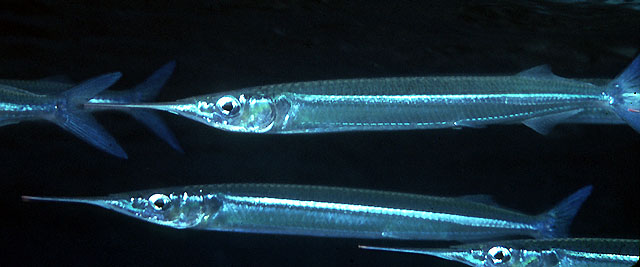
|
Hyporhamphus affinis (Günther, 1866) Tropical halfbeak |
||
| Buging, Tropical halfbeak, Bagiu, Balamban, Balanban, Balitus, Balo, Bamban, Bangdau, Barasot, Bayambang, Boy, Bugi, Bugiw, Doal, Kansusuwit, Kutnog, Laniw, Lulungi, Malamban, Patlay, Sigwil, Siliu, Siliw, Siriw, Suasid, Sugi, Tropical garfish | ||

|
|
photo by
Randall, J.E. |
| Family: | Hemiramphidae (Halfbeaks) | |||
| Max. size: | 38 cm SL (male/unsexed) | |||
| Environment: | reef-associated; marine; depth range 0 - 6 m | |||
| Distribution: | Indo-Pacific: Red Sea and East Africa through the Indian Ocean islands to western Australia, New Guinea, Philippines, and islands of Oceania. Not found in Hawaiian islands, and apparently absent from Indo-Malayan Archipelago. Has been mentioned in the literature under other names, particularly Hyporhamphus erythrorinchus and Hyporhamphus dussumieri (Ref. 10943). | |||
| Diagnosis: | Dorsal spines (total): 0-0; Dorsal soft rays (total): 14-17; Anal spines: 0-0; Anal soft rays: 15-19; Vertebrae: 54-59. Body deep blue above, silvery stripe on side, silvery white below; caudal fin bluish, other fins unpigmented; tip and distal half of underside of lower jaw bright carmine red (Ref. 4164). Description: Characterized by depth of body 8.1-10.6 in SL; well developed anterior lobe of dorsal fin; body width contained 1.1-1.4 in its depth; presence of scales on upper jaw; preordital length much greater than upper jaw length; caudal fin with lower lobe slightly longer than upper (Ref. 90102). | |||
| Biology: | Found chiefly around coral reefs (Ref. 58534) and islands but extends a little further from shore than Hyporhamphus (R.) dussumieri which has a similar range (Ref. 10943). Found in schools (Ref. 9710). Feeds on zooplankton (Ref. 43448) also small fishes and detritius organic matter (Ref. 89972). Eggs covered with adhesive filaments to assist in attaching to floating and benthic objects (Ref. 43448). | |||
| IUCN Red List Status: | Not Evaluated (N.E.) Ref. (130435) | |||
| Threat to humans: | harmless | |||
| Country info: | Known from Sibuyan, Romblon (Ref. 58652). Also Ref. 4164. | |||